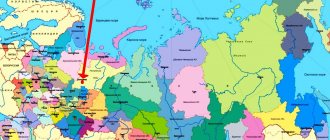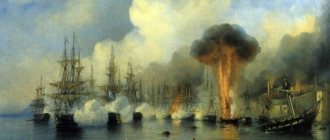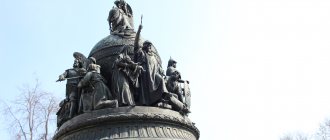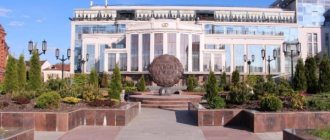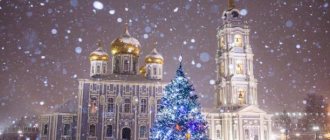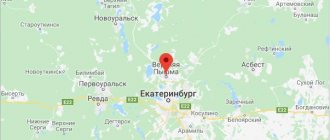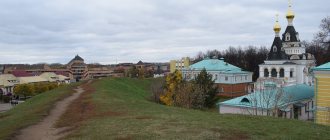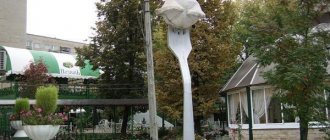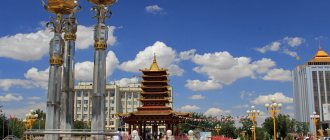Syktyvkar - a city on Sysol
Syktyvkar is the capital of the Komi Republic, the largest region in European Russia. But for all the cultural and historical richness of the region under its control, the city itself is rather faceless. First of all, it is a large industrial center (for example, the largest wood processing plant in Europe is located here), and only then everything else.
The city stands at the confluence of the Sysola River and the Vychegda. In the past it was called Ust-Sysolsk and played an important role on the trade river route that passed here. In the 1920s, the city almost became Vladimir Lenin, and in the 1930s, Joseph Stalin. Its modern name - Syktyvkar - is translated from the Komi language as “City on Sysol”.
Like Arkhangelsk, like Naryan-Mar, it is rather not a city, but an agglomeration of several villages with expressive names: Ezhva, Chovyu, Tentyukovo, Dyrnos, Davpon, Kirul, Kochpon, Paris, Orbita, Meat Processing Plant and, traditionally for the north, Sawmill. The central district of the city, which once was Ust-Sysolsky, is no larger in size than the Central district of Naryan-Mar. But unlike the latter, exactly an order of magnitude more people live in the Syktyvkar agglomeration - no less than almost a quarter of a million.
Syktyvkar is located on the still unfinished Belkomur railway route (White Sea - Komi - Ural), which someday (but this is not certain) will connect Arkhangelsk with Perm. In the meantime, you can get here by rail only along a dead-end road from the Mikun station, located on the Konosha-Vorkuta railway. But right in the center of Syktyvkar there is an airport that has international status. True, you can only fly abroad from here to Antalya and only in the summer.
We had dinner at the Zhakov restaurant. It is located on the first floor of the Syktyvkar hotel. This is one of the best establishments in the city, I recommend it!
When we were in Syktyvkar, the city was preparing to celebrate Maslenitsa.
Maslenitsa effigies flocked to the central square from everywhere to take part in the competition.
The heart of the city is Stefanovskaya Square. Once upon a time there stood a cathedral of the same name.
On a gloomy holiday morning, the square, surrounded by disgusting gray fences, looked uncomfortable. From behind the fence, the granite statue of Vladimir Ilyich looked at the surrounding reality with bewilderment. The monument under it was full of the inscription “Leninly - Komi yozsyan” (translated from Komi - “To Lenin - from the Komi people”). I've only seen something more interesting in Hanoi.
If you don’t look closely, all the capitals of Russian regions under the snow are the same. I could take exactly the same photograph in Vologda or Petrozavodsk.
The architectural appearance of Syktyvkar is like a layer cake.
Its newest layer is the categorically faceless modern high-rise buildings. At their feet, good old wooden houses are living out their last years. Barnaul or Irkutsk, for example, look the same.
Serial Khrushchev-Brezhnev panels in Syktyvkar - even those look more profitable than all this inexpressiveness of the era of petrodollar prosperity.
Balconies and loggias of irregular shape, friezes decorated with national ornaments, colors - all this undoubtedly adds to the city’s originality.
Here are ordinary balconies in a typical Khrushchev 335 series. But they are also decorated with stylish ornaments on neat vertical boards.
It is these details that preserve the architectural exclusivity of Syktyvkar. Unfortunately, local residents do not understand this and believe that it is better to knock it all down by sticking cheap Chinese plastic instead. Ignorant.
Stalin's stone buildings are good by default, especially if their blocks are low-rise. In this way, by the way, Syktyvkar is very similar to Ukhta, only if in the latter the preservation of houses is on the verge of fantasy, then here everything is like everywhere else: randomly glazed balconies, advertising signs and other nonsense.
The photo shows the first fully equipped house in Syktyvkar, which immediately had central heating and hot water supply. It was built in 1939.
I repeat: the low-rise Stalinist Empire style is the best thing that has happened to architecture in Russia since 1918. It is very touching that in Syktyvkar there are caring people who understand this. So, in January 2021, the Soviet neon signs “Gastronomy” and “Grocery” were restored, so wonderfully complementing the image of one of the houses in the city center. Now they have been returned to their rightful place and glow beautifully in the evenings.
Syktyvkar has a huge number of old wooden houses. Some of them are former houses of local merchants (in the foreground, date of construction - 1907), some are Stalinist barracks (in the background, date of construction - 1940). The difference between them, apart from the external decor, is barely perceptible. People still live in both.
On the right is one of the oldest surviving stone buildings: the house of the merchant Oplesnin, 1908. On the left is the building of the Republican Center for Continuing Education; I suspect that this is some kind of antique new building, it’s kind of awkward.
There is no sign of tourism in Syktyvkar, and coming here of your own free will is a dubious idea. The list of official attractions only causes a yawn.
Mushroom Lane is, like, the narrowest in the world (thanks to Natasha Beshkareva for the photo).
In fact, it is just a gap between the houses.
Monument to the letter "Ö". In addition to Komi in Russia, this letter is used in the Mari, Udmurt, Khanty and some Altai languages.
The modern Komi alphabet is based on the Cyrillic alphabet. There are 35 letters in total. In addition to “Ö” there is also “I”, and all the rest are like in Russian.
Memorial "Repentance", in memory of Gulag prisoners.
The National Museum of the Komi Republic welcomes surprised visitors with books on folk art for ten rubles. The books, by the way, are interesting, and in three languages: Russian, Komi and English. I bought myself one.
Komi is a Finno-Ugric people. It is divided into Komi-Zyryans, living mainly in the territory of the Komi Republic, and Komi-Permyaks, living in the north of the Perm Territory. They have one language, but it is divided into a dozen dialects.
In total, there are just under thirty Finno-Ugric peoples in the world: from the Hungarians, Finns and Sami to the Mordovians, Khanty and Mansi. Komi is located in the very center of this amazing Finno-Ugric world.
In Komi mythology there is a sacred tree - As-pu (translated from Komi - “Own tree”). This tree is a human double (it’s interesting that the Nenets also have a similar belief, remember the story about Kozmin’s copse; and in the Russian North there is still a cult of the Sacred Groves). It is believed that each Komi has his own As-pu. To find it, you need to go into the forest with a dog and wait until it starts barking at some tree. If you make a notch on As-pu, blood will start flowing from it. And such a tree can speak with a human voice, and, when cut down, has miraculous powers.
This is all a saying, but here is a fairy tale. A long time ago, the hunter Yirkap lived in Komi. He was able to find As-pu and made magic skis out of it that carried him around the world at incredible speed. There also lived in that region a witch who either intended to marry him to her daughter, or wanted to take possession of his skis, or simply decided to take him for show off - there are many variations of this story. But the result is the same: she turned her daughter into a blue deer and declared that Yirkap would never catch up with him. And the hunter took it and caught up. Then the blue deer turned back into a girl, who began to beg Yirkap not to kill her. But he killed. And he buried it in the ground. And he wrote the inscription. And he took her heart to the witch.
Then again, there are several variants of this myth: either the sorceress decided to take revenge on him and gave him a poisonous potion (according to another version, poisoned water in which his footcloths, that is, foot wraps, were soaked), or Yirkap’s stepmother did this on the instructions of the sorceress , or the witch had nothing to do with it at all, and these were hunters who were jealous of Yirkap’s luck, but, be that as it may, Yirkap then fell through the ice on one of the lakes and died. But that’s not all: according to one version, Yirkap fell through with only one leg, and the second leg came off and, together with the magic ski, crashed into the same As-pu tree.
Legends are legends, but many thousands of years later - in 1964 - during the development of peat, a fragment of an ancient ski was found somewhere between Syktyvkar and Ukhta. Its front part was decorated with the head of an elk, and when moving on these skis, the elk seemed to walk ahead of the person.
The study showed that this fragment is about eight thousand years old (but that is, these skis are almost twice as old as the Egyptian pyramids). Officially, this is the oldest ski in the world, and Komi is now considered the birthplace of this method of transportation.
But the Nenets idols brought here from the Torasoveysky Bay of the Kara Sea seem to me to be more unique exhibits. This is a man and a woman. Their age is unknown, but it is obvious that they are hundreds of years old. It is interesting that these sculptures are created from living wood, and in the place where they were installed there is bare tundra, and the nearest forest is three hundred kilometers away. Their uniqueness lies in the fact that practically no other similar idols have survived to this day - over the course of centuries they were destroyed: first by Christian missionaries, then by communist atheists.
The cultural layer in Komi is quite rich.
On the left are pendants and plaques (III-VIII centuries AD). This is the so-called Perm animal style, a type of bronze sculpture. Under number two you can see a bird of prey - the prototype of the modern coat of arms of the Komi Republic. Number three is an image of a man, and if you look closely at it, you can see the head of an elk. For the ancient Komi, the elk was a sacred animal, a representative of the heavenly world, so it was no coincidence that it was carved on that very ski.
On the right is a bronze figure of a winged woman (IV-V centuries AD).
Well, I don’t think I’ll surprise anyone with spinning wheels. This is a typical attribute of all peasant houses without exception on the European territory of Russia. I will only draw your attention to the abundance of their forms, characteristic exclusively of Komi.
Model of a traditional Komi hut.
All household utensils were not bought, but were always made by the owner of the house.
On the right is a sideboard with solar signs. On the left is the entrance to the golbets, there was a descent into the basement (the lower part of the house). Please note that above the door there is a symbol of water, this is the personification of the underworld.
Traditional wedding dress.
Bassinet, high chair and toy horse.
It is believed that one of the traditional aspects of the ancient Komi culture is brewing. In Komi, this drink has long been called sur. Everyone cooked it except the Izhem Komi people. The recipe for sur is hundreds of years old; each family had its own recipe and was passed on from generation to generation. Traditionally, brewing in Komi was carried out by women.
Sur was a sacred drink. It was used in various rituals. The sur was stored in special wooden barrels and served in duck-shaped bowls (let me remind you that the duck is one of the most important sacred symbols of the Komi people).
The bathhouse occupied a special place in the life of the Komi people. Diseases were treated here, children were given birth, and rituals were performed.
Traditional sauna - of course, black.
Most Komi men were hunters. The traditional hunting dwelling was a small log building with a minimum of amenities, but suitable for long-term living.
Pike teeth were always hung in the corner, considered the most powerful amulet against misfortune. They can still be found today in village houses above doors and windows, and in speech the old answer to swearing and damage is still used: “A pike tooth in your throat!”
Interesting, as always, the details.
Ax holder.
Powder flask and flint bag.
One of the main hunting attributes is skis trimmed with reindeer kamus (skin from the shin of an animal). This technology is still alive: now the lower surface of snowboards is covered with camus.
For one pair of skis, a camus with four or five reindeer was needed. It is not surprising that skis were very valuable - you could easily exchange a cow for them.
The main prey, of course, was fur. In order not to damage animal skins, Komi hunters used bows and arrows when hunting until the beginning of the 20th century.
The most revered of the large animals was the bear. The Komi lived side by side with them for centuries and treated these animals with great respect. They were called brothers, and if they had to kill a bear, the hunter always asked for forgiveness: forgive me, brother, that I have to kill you.
The village of Vylgort adjoins Syktyvkar from the southwest. In fact, this is a Syktyvkar suburb, no different from the chain of villages that extend from the city to the north for a dozen kilometers. But administratively this is no longer Syktyvkar.
Vylgort translated from Komi means “New Housing”. The village has been known since the end of the 16th century. In the past, this was the third largest settlement in Perm Malaya (read: Perm Vychegodskaya), then only Ust-Sysolsk (read: Syktyvkar) and Yarensk were larger. Nowadays, Vylgort is the largest village in the Komi Republic.
There are two attractions in Vylgort. The first is a wooden school building built in 1913.
The second is the House of Folk Crafts “Zaran”. Its log building, although a slightly awkward remake (it was cut down in 2008), is still original and, I would even say, extravagant. It's interesting to look at him.
In the workshops of the House of Crafts, local residents are engaged in artistic processing of wood and birch bark, weaving and pottery, lace making and batik.
The boys are planing.
The girls are drawing.
The looms here are all working.
And the traditions of Vologda lace-making (using bolster pillows and bobbins), apparently, are alive not only in Vologda.
The House of Crafts has its own souvenir shop. According to the recent tradition in the north, all products are signed: name, composition, name of the author.
That's all for today.
Don't switch!
Continuation: Finno-Ugric Ethnopark or Operation Yb
Komi in the Perm region
In the upper basin of the river. Kama, in the Urals, is located the Komi-Permyak Okrug - until 2005, an independent subject of the Russian Federation. Then it was merged with the Perm region, resulting in the creation of the Perm region.
The capital of the Komi-Permyak district - the city of Kudymkar - after the merger became the administrative center of the Kudymkar region. It is located on the tributaries of the Kama - the Inve and Kuva rivers. It is separated from Perm by 200 kilometers.
More than half of the city's population are Komi-Permyaks. In total, about 125 thousand people of this nationality live in the Russian Federation.
Oil capital of Komi
In addition to the administrative center, Syktyvkar, Komi has its so-called oil capital. This is the young city of Usinsk, which is only 30 years old, since it was founded in 1984.
In 1960, the first well was drilled on Usa, in which oil was found. And four years later, the construction of a village for a deep oil exploration expedition began there. A few years later, the Komsomol announced the construction of a well-maintained village, which, in turn, soon became a city. The total volume of oil produced from the fields of the Usinsk region in 1999 exceeded 200 million tons.
Today, Usinsk can rightfully be called the center of the largest oil-producing region in Komi. The main oil producing enterprises are located here: RN-Severnaya Neft, Lukoil-KOMI, Usinskaya Industrial and others.
The 2010 census showed that 47 thousand people live in Usinsk.
Unique place - Weathering pillars
It may not be located in Syktyvkar itself, but the capital of Komi is related to it. If only because it is from there that it is most convenient to get by helicopter to the seventh miracle of Russia, which is called the Weathering Pillars.
They are located in the Troitsko-Pechersk region of the Komi Republic, where the Pechora-Ilychsky Nature Reserve is located. Two hundred million years ago there were high mountains here, which were gradually destroyed by wind, rain, sun and snow. There remain 7 pillars of solid sericite-quartzite slate on the low mountain Man-pupu-ner. All of them have a bizarre shape and height from 30 to 42 meters.
The remains are also called Mansi blockheads, because they were objects of worship for the Mansi people. Many legends are associated with their occurrence. According to one of them, six giants pursued people from the Mansi tribe who were trying to escape beyond the Ural Mountains. At the pass at the source of the Pechora River, when the giants were already overtaking the tribe, a shaman blocked their way and turned them into stone pillars. Since then, all the shamans of the Mansi tribe have drawn their magical power from this sacred tract.
Is it true or not? But many travelers who have visited Mount Man-pupu-ner talk about the extraordinary energy of this place. However, getting there is not so easy. The choice is small: on foot or by helicopter. But the fabulousness of the place is worth the effort.
